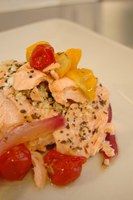Prairie Fare: How Often Do You Eat Fish or Shellfish?
(Click an image below to view a high-resolution image that can be downloaded)
By Julie Garden-Robinson, Food and Nutrition Specialist
NDSU Extension
Have you ever had “food regrets”?
I’m not referring to eating way too much food at Thanksgiving or other holidays.
While I was in Gulfport, Miss., I had the opportunity to try a food that I have pretty much avoided since childhood.
Do you know what foods the Gulf Coast is noted for? Oysters and shrimp are the stars of the Gulf Coast.
I ate my share of shrimp in Mississippi, but I did not eat oysters. Some of my colleagues from around the U.S. ate oysters at every turn. They were “oohing” and “ahhing” about how great they were.
I sat unimpressed eating shrimp in all its forms.
I remember the “oyster soup” from my childhood, which consisted of a can or two of oysters, milk, butter, salt and pepper. We ate what was provided for us for dinner, so I held my breath and ate those oysters.
As I recall, they were greenish gray and odd looking. The milk and butter broth wasn’t too bad, and I liked the little round crackers. I’d float the crackers on the soup and attempt to sneak oysters into my family members’ bowls through some distraction techniques. I think my parents saw me.
Unfortunately, the last night I had shrimp in Mississippi, it tasted like a rubbery mass encased in cardboard that had been in the freezer far too long. That was disappointing.
Now I regret omitting oysters. I might actually like them after all these years, especially when they were made in restaurants specializing in oysters.
Do you meet the recommendations for fish/shellfish? According to the 2015 to 2020 Dietary Guidelines for Americans, we should eat at least 8 ounces of fish/shellfish per week. Shellfish, by the way, includes shrimp, crabs, oysters, lobster, clams, scallops, mussels and crayfish.
A serving is 4 ounces, about the size of the palm of an average-sized adult’s palm.
A drained can of tuna, for example, has about 4 ounces of tuna. A salmon steak has about 4 to 6 ounces.
Fish/shellfish sources provide protein, omega-3 fats, vitamin D, vitamin B-12, iron, selenium, zinc and iodine. Omega-3 fat can improve nervous system development in infants and children.
According to the Food and Drug Administration, oysters and shrimp are on the “best choice” list in terms of mercury levels. Catfish, cod, haddock, herring, lobster, perch, salmon, sardines, tilapia and several other types also are on the “best choice” list. King mackerel, marlin, orange roughy, shark, swordfish, tile fish and bigeye tuna are on the “choices to avoid” list.
For children, a serving is 1 ounce at age 2, and it increases to 4 ounces at age 11.
Women who are pregnant should choose lower-mercury types of fish and shellfish and consult their state’s Department of Natural Resources to learn about mercury levels in locally caught fish.
Eating a variety of foods from every food group is a hallmark of good nutrition. If you decide to add a couple of servings of fish to your weekly menu, consider these tips:
- Keep it lean and flavorful. Try grilling, broiling and baking fish. These methods do not add extra fat. Breading and frying fish adds calories and fat.
- Cook shrimp, lobster and scallops until they are opaque (milky white). Cook fish to 145 F until it flakes with a fork.
- Get creative with seafood. Try salmon patties, a shrimp stir-fry or grilled fish tacos.
- Shop smart. Adding a meal or two with fish/shellfish doesn’t have to break your food budget. Try canned tuna and shop the sales.
I haven’t made “friends” with oysters just yet, but you can find recipes at the Mississippi Seafood website: https://msseafood.com/cook.
Here’s a recipe our student interns tried with success.
Fresh Herbed Salmon Packets
4 (5-oz.) salmon fillets
4 tsp. olive oil
2 garlic cloves
4 tsp. dried basil
40 cherry tomatoes
1 medium red onion, cut into 8 wedges
4 Tbsp. lemon juice (juice of about one lemon)
Salt and pepper to taste (about 1/8 tsp. per salmon fillet)
Preheat oven to 400 F. Make four square pieces of foil and place a salmon filet in the middle of each one. Drizzle 1 tsp. of olive oil over the salmon filet. Add a pinch of salt and pepper. Mince garlic cloves and divide evenly among each filet. Sprinkle each fillet with 1 tsp. of dried basil. Add 10 cherry tomatoes and two onion wedges per foil. Add 1 Tbsp. fresh squeezed lemon juice over each salmon fillet. Wrap the foil so the salmon is completely covered and bake for 15 minutes, until the internal temperature is 145 F according to a food thermometer measurement. The salmon should flake with a fork. If the salmon fillets are thick, they may need an extra few minutes in the oven.
Makes four servings. Each serving has 290 calories, 15 grams (g) fat, 30 g protein, 12 g carbohydrate, 3 g fiber and 360 milligrams sodium.
(Julie Garden-Robinson, Ph.D., R.D., L.R.D., is a North Dakota State University Extension food and nutrition specialist and professor in the Department of Health, Nutrition and Exercise Sciences. Follow her on Twitter @jgardenrobinson)
NDSU Agriculture Communication - Jan. 30, 2020
| Source: | Julie Garden-Robinson, 701-231-7187, julie.garden-robinson@ndsu.edu |
|---|---|
| Editor: | Ellen Crawford, 701-231-5391, ellen.crawford@ndsu.edu |



